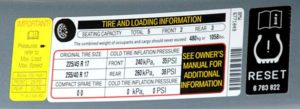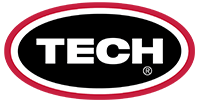TECH Summer Tire Maintenance Tips
As the Global Tire & Wheel authority, TECH reminds you that with the summer driving season upon us, now is the time to be taking the necessary steps to ensure that your next trip sees you safely to your destination. Proper tire inflation maintenance is the most important step to ensuring your tires remain safe and achieve their most efficient tread life. But what exactly is the proper inflation pressure for your tires?
 The first step to understanding the proper inflation pressure for your tires is to know where to look to find this information. The pressure stamped on the sidewall of your tires is not typically the recommended pressure for everyday driving. Instead, this is the maximum pressure allowable for your tires at its maximum load carrying capacity. For vehicles manufactured in the last 15 years, you will find a Tire and Loading Information placard affixed to the driver side door jamb that will notify you of the proper inflation pressure for each of your tires. Older vehicles will also have a similar placard, but it may be found in a different location.
The first step to understanding the proper inflation pressure for your tires is to know where to look to find this information. The pressure stamped on the sidewall of your tires is not typically the recommended pressure for everyday driving. Instead, this is the maximum pressure allowable for your tires at its maximum load carrying capacity. For vehicles manufactured in the last 15 years, you will find a Tire and Loading Information placard affixed to the driver side door jamb that will notify you of the proper inflation pressure for each of your tires. Older vehicles will also have a similar placard, but it may be found in a different location.
It is also important to know when to check your tire pressure. Early morning, when temperatures are their coolest and before you have driven your vehicle is the best time to do your pressure checks. The reason for this is that tire inflation pressure has a direct correlation to ambient temperature. For every 10°F change in temperature, your tire pressure will rise or fall 1-2 psi. This means that if you inflate your tires in the afternoon when the temperature is 90° and the temperature falls to 70° overnight, then your pressure will be 2 psi lower in the morning. Your tires will also experience a 2-4 psi increase while driving, which could make any pressure check you make after driving inaccurate.
Along with allowing your tires to get their safest and longest possible life, proper tire pressure also helps your vehicle get its best fuel economy. A pressure drop of 3 psi below the recommended pressure could lead to a 1% drop in fuel economy.
Also, visually inspect your tires for excessive wear, cracking in the sidewall also for any bulges or cuts in either the tread or sidewall. All of these could indicate areas for potential tire failure. If you have any concerns visit your nearest tire repair shop and have them look at your tires before you hit the road. Should your tire need repaired make sure they use TECH tire repair products. With billions of tires repaired, TECH is the brand top technicians have trusted for 80 years.
To ensure that your next trip is a safe one, remember to thoroughly check your tires before departing. Safe driving from your friends at TECH.



Recent Comments